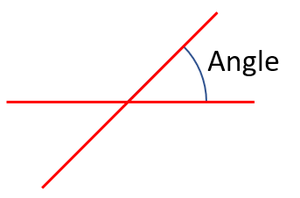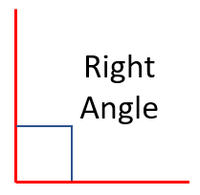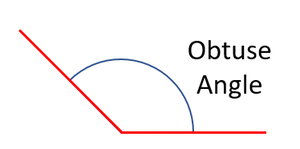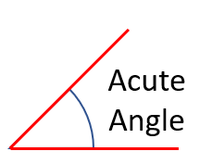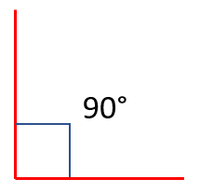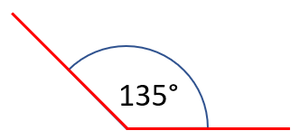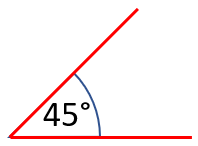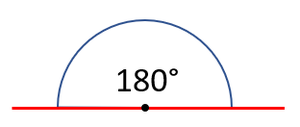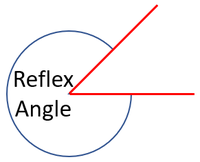Difference between revisions of "Angle"
(→Lower Key Stage 2) |
|||
| (6 intermediate revisions by one other user not shown) | |||
| Line 37: | Line 37: | ||
===About Angles=== | ===About Angles=== | ||
: [[Angle]]s are measured in [[degree]]s (°). | : [[Angle]]s are measured in [[degree]]s (°). | ||
| − | : There are 360 [[degree]]s (360°) | + | : A [[protractor]] can be used to [[measure]] the [[angle]] between to lines. |
| + | : There are 360 [[degree]]s (360°) around a point. | ||
| + | {| class="wikitable" | ||
| + | |- | ||
| + | |[[File:AngleAroundaPoint.png|center|300px]] | ||
| + | | style="height:20px; width:300px; text-align:center;" |The total [[angle]] around a point is 360°. | ||
| + | |} | ||
: There are 90 [[degree]]s (90°) in a [[Right Angle|right angle]]. | : There are 90 [[degree]]s (90°) in a [[Right Angle|right angle]]. | ||
| + | {| class="wikitable" | ||
| + | |- | ||
| + | |[[File:RightAngleDegree.png|center|200px]] | ||
| + | |[[File:SquareRightAngles.png|center|300px]] | ||
| + | |- | ||
| + | | style="height:20px; width:300px; text-align:center;" |A [[diagram]] showing that a [[Right Angle|right angle]] is 90°. | ||
| + | | style="height:20px; width:300px; text-align:center;" |There are 4 [[Right Angle|right angles]] in a [[square]] or a [[rectangle]] so the total [[angle]]s inside added together makes 360° | ||
| + | |} | ||
: An [[angle]] that is bigger than 90° is called [[obtuse]]. | : An [[angle]] that is bigger than 90° is called [[obtuse]]. | ||
| + | {| class="wikitable" | ||
| + | |- | ||
| + | |[[File:135degrees.png|center|300px]] | ||
| + | | style="height:20px; width:300px; text-align:center;" |This [[angle]] is bigger than 90° so it is [[obtuse]]. | ||
| + | |} | ||
: An [[angle]] that is smaller than 90° is called [[acute]]. | : An [[angle]] that is smaller than 90° is called [[acute]]. | ||
| + | {| class="wikitable" | ||
| + | |- | ||
| + | |[[File:45degrees.png|center|200px]] | ||
| + | | style="height:20px; width:400px; text-align:center;" |This [[angle]] is smaller than a 90° so it is [[acute]]. | ||
| + | |} | ||
| + | |||
| + | : The [[angle]] on a straight line is 180°. | ||
| + | {| class="wikitable" | ||
| + | |- | ||
| + | |[[File:AngleonaLine.png|center|300px]] | ||
| + | |[[File:TwoAnglesonaLine.png|center|300px]] | ||
| + | |- | ||
| + | | style="height:20px; width:300px; text-align:center;" |A [[diagram]] showing 180° on a line. | ||
| + | | style="height:20px; width:300px; text-align:center;" |These two [[angle]]s add up to 180° because they are part of a straight line. | ||
| + | |} | ||
| + | |||
| + | : A [[Reflex Angle|reflex angle]] is the [[angle]] on the opposite side of another [[angle]]. | ||
| + | |||
| + | {| class="wikitable" | ||
| + | |- | ||
| + | |[[File:ReflexAngle.png|center|200px]] | ||
| + | | style="height:20px; width:400px; text-align:center;" |An [[angle]] added to its [[Reflex Angle|reflex angle]] makes 360°. | ||
| + | |} | ||
| + | ==Key Stage 3== | ||
| + | ===Meaning=== | ||
| + | [[File:Angle.png|right|300px|thumb|A [[diagram]] showing two intersecting crossing to form an [[angle]].]] | ||
| + | An [[angle]] is the space between two intersecting straight lines. | ||
| + | |||
| + | ===About Angles=== | ||
| + | : [[Angle]]s are measured in [[degree]]s (°). | ||
| + | : A [[protractor]] can be used to [[measure]] the [[angle]] between two intersecting lines. | ||
| + | : There are 360 [[degree]]s (360°) around a point. | ||
| + | {| class="wikitable" | ||
| + | |- | ||
| + | |[[File:AngleAroundaPoint.png|center|300px]] | ||
| + | | style="height:20px; width:300px; text-align:center;" |The total [[angle]] around a point is 360°. | ||
| + | |} | ||
| + | : There are 90 [[degree]]s (90°) in a [[Right Angle|right angle]]. | ||
| + | {| class="wikitable" | ||
| + | |- | ||
| + | |[[File:RightAngleDegree.png|center|200px]] | ||
| + | |[[File:SquareRightAngles.png|center|300px]] | ||
| + | |- | ||
| + | | style="height:20px; width:300px; text-align:center;" |A [[diagram]] showing that a [[Right Angle|right angle]] is 90°. | ||
| + | | style="height:20px; width:300px; text-align:center;" |There are 4 [[Right Angle|right angles]] in a [[square]] or a [[rectangle]] so the total [[angle]]s inside added together makes 360° | ||
| + | |} | ||
| + | : An [[angle]] that is bigger than 90° is called [[obtuse]]. | ||
| + | {| class="wikitable" | ||
| + | |- | ||
| + | |[[File:135degrees.png|center|300px]] | ||
| + | | style="height:20px; width:300px; text-align:center;" |This [[angle]] is bigger than 90° so it is [[obtuse]]. | ||
| + | |} | ||
| + | : An [[angle]] that is smaller than 90° is called [[acute]]. | ||
| + | {| class="wikitable" | ||
| + | |- | ||
| + | |[[File:45degrees.png|center|200px]] | ||
| + | | style="height:20px; width:400px; text-align:center;" |This [[angle]] is smaller than a 90° so it is [[acute]]. | ||
| + | |} | ||
| + | |||
| + | : The [[angle]] on a straight line is 180°. | ||
| + | {| class="wikitable" | ||
| + | |- | ||
| + | |[[File:AngleonaLine.png|center|300px]] | ||
| + | |[[File:TwoAnglesonaLine.png|center|300px]] | ||
| + | |- | ||
| + | | style="height:20px; width:300px; text-align:center;" |A [[diagram]] showing 180° on a line. | ||
| + | | style="height:20px; width:300px; text-align:center;" |These two [[angle]]s add up to 180° because they are part of a straight line. | ||
| + | |} | ||
| + | |||
| + | : A [[Reflex Angle|reflex angle]] is the [[angle]] on the opposite side of another [[angle]]. | ||
| + | |||
| + | {| class="wikitable" | ||
| + | |- | ||
| + | |[[File:ReflexAngle.png|center|200px]] | ||
| + | | style="height:20px; width:400px; text-align:center;" |An [[angle]] added to its [[Reflex Angle|reflex angle]] makes 360°. | ||
| + | |} | ||
| + | |||
| + | ==Key Stage 4== | ||
| + | ===Meaning=== | ||
| + | [[File:Angle.png|right|300px|thumb|A [[diagram]] showing two intersecting crossing to form an [[angle]].]] | ||
| + | An [[angle]] is the space between two intersecting straight lines. | ||
| + | |||
| + | ===About Angles=== | ||
| + | : [[Angle]]s are measured in [[degree]]s (°). | ||
| + | : A [[protractor]] can be used to [[measure]] the [[angle]] between two intersecting lines. | ||
| + | : There are 360 [[degree]]s (360°) around a point. | ||
| + | {| class="wikitable" | ||
| + | |- | ||
| + | |[[File:AngleAroundaPoint.png|center|300px]] | ||
| + | | style="height:20px; width:300px; text-align:center;" |The total [[angle]] around a point is 360°. | ||
| + | |} | ||
| + | : There are 90 [[degree]]s (90°) in a [[Right Angle|right angle]]. | ||
| + | {| class="wikitable" | ||
| + | |- | ||
| + | |[[File:RightAngleDegree.png|center|200px]] | ||
| + | |[[File:SquareRightAngles.png|center|300px]] | ||
| + | |- | ||
| + | | style="height:20px; width:300px; text-align:center;" |A [[diagram]] showing that a [[Right Angle|right angle]] is 90°. | ||
| + | | style="height:20px; width:300px; text-align:center;" |There are 4 [[Right Angle|right angles]] in a [[square]] or a [[rectangle]] so the total [[angle]]s inside added together makes 360° | ||
| + | |} | ||
| + | : An [[angle]] that is bigger than 90° is called [[obtuse]]. | ||
| + | {| class="wikitable" | ||
| + | |- | ||
| + | |[[File:135degrees.png|center|300px]] | ||
| + | | style="height:20px; width:300px; text-align:center;" |This [[angle]] is bigger than 90° so it is [[obtuse]]. | ||
| + | |} | ||
| + | : An [[angle]] that is smaller than 90° is called [[acute]]. | ||
| + | {| class="wikitable" | ||
| + | |- | ||
| + | |[[File:45degrees.png|center|200px]] | ||
| + | | style="height:20px; width:400px; text-align:center;" |This [[angle]] is smaller than a 90° so it is [[acute]]. | ||
| + | |} | ||
| + | |||
| + | : The [[angle]] on a straight line is 180°. | ||
| + | {| class="wikitable" | ||
| + | |- | ||
| + | |[[File:AngleonaLine.png|center|300px]] | ||
| + | |[[File:TwoAnglesonaLine.png|center|300px]] | ||
| + | |- | ||
| + | | style="height:20px; width:300px; text-align:center;" |A [[diagram]] showing 180° on a line. | ||
| + | | style="height:20px; width:300px; text-align:center;" |These two [[angle]]s add up to 180° because they are part of a straight line. | ||
| + | |} | ||
| + | |||
| + | : A [[Reflex Angle|reflex angle]] is the [[angle]] on the opposite side of another [[angle]]. | ||
| + | |||
| + | {| class="wikitable" | ||
| + | |- | ||
| + | |[[File:ReflexAngle.png|center|200px]] | ||
| + | | style="height:20px; width:400px; text-align:center;" |An [[angle]] added to its [[Reflex Angle|reflex angle]] makes 360°. | ||
| + | |} | ||
| + | |||
| + | ===References=== | ||
| + | ====OCR==== | ||
| + | |||
| + | :[https://www.amazon.co.uk/gp/product/0198359837/ref=as_li_tl?ie=UTF8&camp=1634&creative=6738&creativeASIN=0198359837&linkCode=as2&tag=nrjc-21&linkId=3c4229e8b023b2b60768e7ea2307cc6f ''Angles, pages 291, Gateway GCSE Physics, Oxford, OCR ''] | ||
Latest revision as of 16:50, 30 November 2019
Contents
Lower Key Stage 2
Meaning
An angle is the space between two straight lines that cross each other.
About Angles
- Angles are labelled between two lines that cross over.
- The angles inside a square or rectangle are described as right angles.
| A diagram showing a right angle between two lines. | There are 4 right angles in a square or a rectangle. |
- An angle that is bigger than a right angle is called obtuse.
| This angle is bigger than a right angle so it is obtuse. |
- An angle that is smaller than a right angle is called acute.
| This angle is smaller than a right angle so it is acute. |
Upper Key Stage 2
Meaning
An angle is the space between two straight lines that cross each other.
About Angles
- Angles are measured in degrees (°).
- A protractor can be used to measure the angle between to lines.
- There are 360 degrees (360°) around a point.
| The total angle around a point is 360°. |
- There are 90 degrees (90°) in a right angle.
| A diagram showing that a right angle is 90°. | There are 4 right angles in a square or a rectangle so the total angles inside added together makes 360° |
| This angle is bigger than 90° so it is obtuse. |
| This angle is smaller than a 90° so it is acute. |
- The angle on a straight line is 180°.
| A diagram showing 180° on a line. | These two angles add up to 180° because they are part of a straight line. |
- A reflex angle is the angle on the opposite side of another angle.
| An angle added to its reflex angle makes 360°. |
Key Stage 3
Meaning
An angle is the space between two intersecting straight lines.
About Angles
- Angles are measured in degrees (°).
- A protractor can be used to measure the angle between two intersecting lines.
- There are 360 degrees (360°) around a point.
| The total angle around a point is 360°. |
- There are 90 degrees (90°) in a right angle.
| A diagram showing that a right angle is 90°. | There are 4 right angles in a square or a rectangle so the total angles inside added together makes 360° |
| This angle is bigger than 90° so it is obtuse. |
| This angle is smaller than a 90° so it is acute. |
- The angle on a straight line is 180°.
| A diagram showing 180° on a line. | These two angles add up to 180° because they are part of a straight line. |
- A reflex angle is the angle on the opposite side of another angle.
| An angle added to its reflex angle makes 360°. |
Key Stage 4
Meaning
An angle is the space between two intersecting straight lines.
About Angles
- Angles are measured in degrees (°).
- A protractor can be used to measure the angle between two intersecting lines.
- There are 360 degrees (360°) around a point.
| The total angle around a point is 360°. |
- There are 90 degrees (90°) in a right angle.
| A diagram showing that a right angle is 90°. | There are 4 right angles in a square or a rectangle so the total angles inside added together makes 360° |
| This angle is bigger than 90° so it is obtuse. |
| This angle is smaller than a 90° so it is acute. |
- The angle on a straight line is 180°.
| A diagram showing 180° on a line. | These two angles add up to 180° because they are part of a straight line. |
- A reflex angle is the angle on the opposite side of another angle.
| An angle added to its reflex angle makes 360°. |
